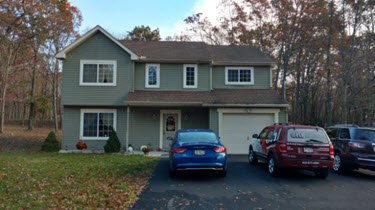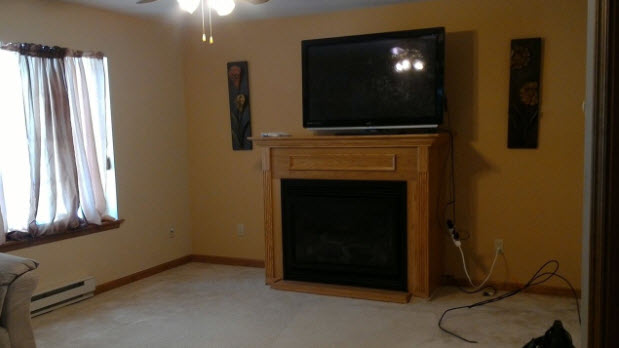Albrightsville PA Home Gets Clean Heat With Direct Vent Fireplace
 Everybody loves a roaring fireplace in the winter. And, for the last few decades, just about anyone could have one in their home. But, they’re not all made the same. That’s why our homeowner called us to switch from vent free to a direct vent propane setup.
Everybody loves a roaring fireplace in the winter. And, for the last few decades, just about anyone could have one in their home. But, they’re not all made the same. That’s why our homeowner called us to switch from vent free to a direct vent propane setup.
She had a vent free model for years. On paper, it made sense. Those are much cheaper than the ones she was considering for a replacement. And, they’re also more efficient.
But, hers didn’t work as well as she wanted it to. Even though it was easy to use and simple to install, it wasn’t worth it. So, she called us to see what her options were.
We went through some different models and heating sources. Then, once she chose the one she wanted, we got to work.
Problem: A homeowner in Albrightsville, PA wanted to get rid of her vent free fireplace. It gave off a smell and added too much humidity to the room.
Solution: Installed a direct vent fireplace with propane heat.
What Are Direct-Vent And Vent-Free Fireplaces?
A direct vent fireplace is one where the smoke and exhaust exit the house directly through a pipe or chimney. When you picture an old-fashioned mantle with burning logs int it and smoke going up the chimney, that’s one example.
Today, you can also purchase ones that don’t need a chimney. Instead, the exhaust from the fire exits through a specialized pipe. Installers will find a place to install this so the unit vents properly. But, it’s still less costly and less work than building a masonry smokestack.
Additionally, direct vent models rarely use actual firewood. Instead, the flames and heat often come from natural gas. Installers hook up a line from a tank or the house’s line to funnel in the gas.
Even though they cost less than a traditional masonry setup, these are more expensive than vent-free ones.
Those models don’t require pipes, chimneys or any sort of vent. Like the other models, they also rely on natural gas or electricity to create a fire. But, they are designed to emit minimal exhaust fumes.
This way, they operate as standalone appliances. Homeowners can place them almost anywhere, particularly the electric models. Those don’t even require piping for natural gas.
And, they’re the most efficient, using 99 percent of the fuel it gets for the fire. Other models lose much more in the exhaust process.
Of course, there are some downsides down to the ventless ones. After all, this homeowner was looking to get rid of hers. Here’s how the two compare.
Vent-Free Vs. Direct Vent
Vent-free sound almost too good to be true. They’re cheaper than other options and require much less work to install. But, they don’t have quite the same effect. And, more and more people are choosing direct vent instead, even though those are more expensive.
In fact, there’s a degree of controversy over vent free setups. The problem is the exhaust. With no venting, any smoke, carbon monoxide or other pollutants remain in the house.
Of course, manufacturers are adamant that the emissions are very low. And, they still need to meet federal standards for all combustible heating appliances.
In particular, they are required by the National Fire Protection Association to have carbon monoxide and oxygen sensors installed. This way, they shut off automatically if the carbon monoxide level raises too high.
But, not everyone believes they’re as safe as they’re made out to be. In fact, some towns across the country have banned them.
Our homeowner in Albrightsville wanted to switch because of what she experienced herself. Her fireplace definitely lets off a gassy smell. It most likely wasn’t dangerous, but it was certainly unpleasant.
She also noticed that her living room became much more stuffy and humid when the unit was on. This is common also. And, it can be more than just uncomfortable. Too much moisture in a house can cause wooden window frames to rot and wallpaper to peel.
And, it also helps create a breeding ground for dust mites, fungus, and mold. These contaminants thrive in dark, moist places. Since the windows are closed in the winter, when the fire is roaring, they’re more likely to take root with less air circulation than in the spring or fall.

Installing A New Direct Vent Fireplace
Our homeowner understood that a new direct vent fireplace would cost more than her ventless model. But, she loved the effect of a roaring fire. And, it made an excellent supplemental heat source on cold nights and during power outages.
So, we did what we could to keep the costs down on her new model. The first thing we did was make sure to use a propane model. This would help out in a few ways.
First, propane is a very clean-burning gas. It emits almost no carbon monoxide or other pollutants. Even central systems give off a certain amount of the poisonous gas. But, it vents out of the house rather than ever enter the ductwork.
Even with venting, however, there are still smoke and flames in the room. Now, there’s as little exhaust as possible.
Next, propane is especially efficient. We can’t get as close to 99 percent efficiency with the ventless model. But, this one loses just five percent of fuel to exhaust. That’s still exceptionally high. Compare that to oil heat and other options, where that number is often closer to 85 percent.
With all that in mind, we installed the new model in our homeowner’s living room. It almost looks like an old-fashioned mantle with a large opening and ornate wood facade. And, she’s able to place her television right above it. This way, the room has just one focal point.
Now, our homeowner can relax with her favorite shows and a roaring fire. On chilly nights, she’ll enjoy some extra warmth. And, she doesn’t have to worry about any weird smells or humidity while she does so.
Are you considering a switch to a cleaner-burning fireplace? Contact us, and we’ll help you choose and install the model that’s right for your home.
